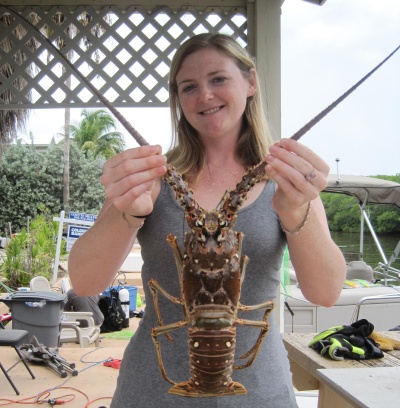Interesting Facts About Florida Lobsters
Types of Lobsters
The main difference in types of lobsters can be seen by the claws or pinchers. The American
or Maine Lobster has large front claws while the Florida Spiny Lobster does not.
The clawed lobsters are often called cold water lobsters due to their normal habitat locations. The spiny, rock, or Florida lobster
is generally considered a warm water lobster. The Florida Lobsters are most commonly caught for their tail meat, while the Maine lobster is known for it's claw and tail meat.
 Baby Lobsters
The female Florida lobster holds up to a million eggs during the reproductive season
of 9-10 weeks. The eggs begin soft in texture and bright orange in color. As the eggs
mature, their color darkens and the eggs become hard.
Young larvae and juvenile lobster stay in shallow waters to hide from predators. One
of the most common predators of the Florida lobster is the Lionfish. The Lionfish can
consume over 20 small baby lobsters or wrasses in a 30 minute timeframe. As the lobster
growth, so do their predators. Example of Adult lobster predators are eels and sharks.
Lobster Migration
As the small lobsters grow, they will migrate to deeper water. Lobsters also migrate
during the year as the water temperatures change. Generally in the fall the lobsters
will do to deeper water to avoid the cold shallow water. In the spring as the shallow
water warms, the lobsters return.
Storms are often a cause for migration as well. It is speculated that tropical and
winter storms are a strong factor in lobster populations and habitats. Scientists
have written about how the Florida spiny lobster is a descendant of the Caribbean
Spiny lobster due to large water circulation patterns and weather patterns transporting
the lobster larvae long distances.
Lobster Coloring and Feeding
Spiny lobsters generally eat at night, preying on small slow-moving species such as
smaller crustaceans, mollusks, chiton and bivalves. Lobster coloring is highly determined
by the foods they eat. The prey that the lobsters eat is often covered in algae and the
color of the algae differs with the depth of the water. Green alga is more common is
shallow waters and therefore lobsters in shallow water tend to be more green than red.
Red alga is more common in deep water, giving deep water lobsters a redder tint in their
shells.
Baby Lobsters
The female Florida lobster holds up to a million eggs during the reproductive season
of 9-10 weeks. The eggs begin soft in texture and bright orange in color. As the eggs
mature, their color darkens and the eggs become hard.
Young larvae and juvenile lobster stay in shallow waters to hide from predators. One
of the most common predators of the Florida lobster is the Lionfish. The Lionfish can
consume over 20 small baby lobsters or wrasses in a 30 minute timeframe. As the lobster
growth, so do their predators. Example of Adult lobster predators are eels and sharks.
Lobster Migration
As the small lobsters grow, they will migrate to deeper water. Lobsters also migrate
during the year as the water temperatures change. Generally in the fall the lobsters
will do to deeper water to avoid the cold shallow water. In the spring as the shallow
water warms, the lobsters return.
Storms are often a cause for migration as well. It is speculated that tropical and
winter storms are a strong factor in lobster populations and habitats. Scientists
have written about how the Florida spiny lobster is a descendant of the Caribbean
Spiny lobster due to large water circulation patterns and weather patterns transporting
the lobster larvae long distances.
Lobster Coloring and Feeding
Spiny lobsters generally eat at night, preying on small slow-moving species such as
smaller crustaceans, mollusks, chiton and bivalves. Lobster coloring is highly determined
by the foods they eat. The prey that the lobsters eat is often covered in algae and the
color of the algae differs with the depth of the water. Green alga is more common is
shallow waters and therefore lobsters in shallow water tend to be more green than red.
Red alga is more common in deep water, giving deep water lobsters a redder tint in their
shells.
|
|
|
|